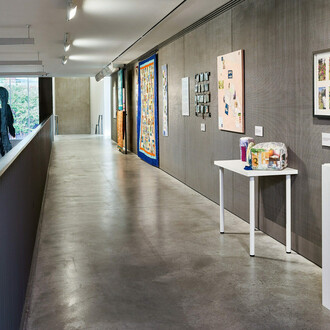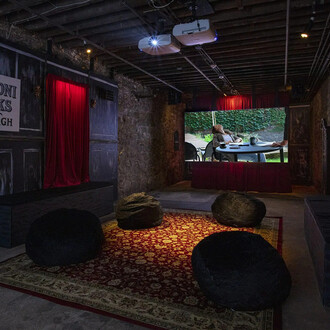In the Fall of 2012, the Galleries at Katara Cultural Village, Doha, Qatar, will present a special solo exhibition featuring the contemporary work of Iranian-American artist Eric Parnes. It is the first one-man show of this artist in the region. From the exhibition catalog:
Eric Parnes’ body of work reflects the experiences of a younger generation that came of age between the Middle East and the West. Whether through travel, television or the music we listened to, all of these references have shaped our visual culture; creating an art form that resonates with the viewer precisely because it presents an emotional connection to their past. While illustrating the affects of globalization on a rapidly evolving Middle East, this kind of art ultimately highlights a cross-cultural conversation that has been going on for centuries. Deena Aljuhani Abdulaziz
The interplay and exchange of ideas between East and West has never been more important than it is currently and artists are in turn critical players in keeping that dialogue fresh, alive and honest. In I Dream of Jeannie: I See Demons, Eric Parnes offers a new perspective on an old theme - the ways in which East and West see one another, the stereotypes on the surface and the more complex realities beneath it. Eric is a product of both cultures, and he is by disposition and background well-suited for the task he has set himself. His contemporary take on Orientalism is perceptive, witty and resonant. M. Shafik Gabr "Masterpieces of Orientalist Art: The Shafik Gabr Collection" (London: ACR, 2012)
The work of artist Eric Parnes - also known as Eric Esmail Parnes - is of a multimedia nature. It has been presented in a wide variety of mediums, including mixed media objects and sculptures, paintings, video installations, photography, and unique materials, often utilizing internationally-known logos and corporate symbols in an examination of Middle Eastern cultures as seen within the constantly evolving landscape of globalization.
The artist’s work has developed to incorporate both his cultural and ethnic heritage as an American of Iranian descent, and is in particular noted for successfully exploring the ongoing history of Oriental imagery in both the West and the East, in their past and present reincarnations. Parnes has appropriately referred to his own individual style of art as that of a "Neo-Orientalist™" (like "Neo-Orientalism,™" terms trademarked by Eric Parnes in an additional reflection of the ongoing transformation of language and the rebirth of world cultures in commercialism).
Eric Parnes’ work effectively conveys a revealing examination of the redesigned experience of Orientalism as it can be felt today. His work appears to philosophically salvage from both the old and the new, emerging with valuable elements of classical Persia and from astute representations of the 21st century Middle East. Intermittently incorporating visual souvenirs of the greater Babylonian empire, the art of Eric Parnes also converges with articulate contemporary symbols of the ever-developing modern-day Orient as it continues to ubiquitously influence our intensely globalizing and immersive world culture.
In the exhibition of Parnes’ pieces assembled for I Dream of Jeannie: I See Demons, the artist touches upon a phenomena of late 1960’s Americana, that generated a remarkably powerful influence of aesthetic and musical fantasy still resonating to this day: the creation of a hit romantic comedy television series entitled I Dream of Jeannie. Starring actress Barbara Eden in the title role of a female genie, the show aired for an entire five seasons from September 1965 to May 1970. It is of interest that the show’s premise was conceived of in the time following the much-publicized official visit of the Shah of Iran to the United States during the Kennedy Administration. The show’s late creator Sidney Sheldon’s complete metamorphosis of a genie played by a blonde, blue-eyed female, fiercely propelled I Dream of Jeannie’s reinvention of ancient Persian mysticism into the Western psyche and forever influenced the cultural landscape.
“The TV show then entered the mainstream vernacular of the typical American and still maintains its influence,” reflects the artist Eric Parnes.
In the pilot episode of the now-classic TV show, the lead female character of I Dream of Jeannie begins speaking in the Farsi (Persian) language, although Sheldon’s original script appears to state that her lines are to be read in an “Arabic” language; showcasing Hollywood’s confusing goulash of attempting to portray ” the exotic allure of Orientalism and the Middle East. At the same time, the choice of language is interestingly accurate, as the backdrop story of the One Thousand and One Nights tales (commonly known in the West as Arabian Nights) is primarily structured on famed Pahlavi literature of Persia. As the television show proceeded, Jeannie later began to exclusively speak in English, with rare exceptions. In the show, astronaut Captain Tony Nelson (played by Larry Hagman) abandons a malfunctioning spaceship shortly after lift-off and crashes somewhere between India and Australia. Finding himself on a deserted Island Beach, he decides to write an S.O.S. on the sands (seaman’s code for “Save Our Ship”) in the hopes he will be noticed and rescued. While doing so, he finds an ornate green vial to complete the final “S” in the distress signal. Accidentally rubbing the bottle, smoke emerges from the piece and the beautiful blonde genie Jeannie appears, declaring in Persian, “Bendeh Beh Goosheh Farmaneh To Hastam Sardar [your wish is my command, Master].” “My heart sings at having such a handsome master,” she says to the stunned Captain Nelson, “I am yours to command... Sheklat mesleh Seemayekh Khalif Hast [‘you have the face of a wise and fearless Caliph,’ according to Sheldon’s pilot script].” “I must have gone further into orbit,” the bewildered astronaut declares. “I’ve read about genies, ...it's like something out of Arabian Nights.”
Parnes points out that the name of the television show itself, I Dream of Jeannie, is a play on the French word “genie,” a derivative emerging directly from the Arabic word “Jinn” (a supernatural being mentioned in the Holy Koran). The Western concepts of the genie usually range from the wondrously benign to the downright mischievous. Yet, in the Middle East, the Jinn is reportedly most often identified as having negative intentions of mischief-making and trouble-doing. Accordingly, the artist further states, when translating the show’s famous American title into a poetic Farsi, the context instead suggests - quite literally - I See Demons.
It has been almost half a century since the show’s television debut. But the masses continue to be pulled to the hypnotic allure of Jeannie, as references to the character and show constantly show up across the spectrum of modern and contemporary pop culture. It is likely one of the most prevailing and resonating examples of 20th century America's spin on the alluring sociocultural beauty of the Middle East's traditional fashions and ancient folklore.
It is of especial interest to note that Jeannie's famous bottle was not specifically manufactured for the show. The actual bottle was a 1964 Jim Beam Bourbon Whiskey liquor decanter, produced as a specialty release for Christmas that year. It was created by a commercial designer by the name of Roy Kramer for the Wheaton Bottle Company, clearly influenced by a Middle Eastern design. Reportedly, Jim Beam Distillery’s President at the time, Martin Lewin, had travelled through Europe to inspect the company’s branches situated overseas; and during a trip to Germany in 1963, he noted a Middle Eastern decanter that would eventually become the holiday edition of the whiskey and later the vessel for Jeannie. Aside from its usage in the television show, Eric Parnes notes, the bottle’s manufactured intention to specifically serve Haraam (for sinful purpose [alcohol] in Islamic tradition), serves another controversially menacing dichotomy in itself.
Reproduced by the artist in porcelain, utilizing a select choice of single colors, the bottle becomes a symbolic fine art sculpture and finds newfound meaning in the exhibition’s piercing dual title. In the compelling argument that contemporary art has replaced the role of new philosophy in today’s society, we now may find that reflective imagery, in all sorts of mediums not only limited to painting and sculpture, can teach us much about understanding our past as well as the present state of our human condition. Parnes’ aesthetic contribution to the latest evolution of the Jeannie vessel makes the sculpture one of the strongest expressions of Orientalism, in the bottle’s overall journey in the West to its current reincarnation as a work of stirring symbolism in contemporary fine art.
“The selection of works in this exhibition examines the broader implications of the dynamics between the East and the West, as based in his program,” remarks the artist. Here, Parnes’ engaging photographs of Middle Eastern women adorned with an unexpectedly pink headpiece reminiscent of the Jeannie character, with matching pink scarves, subtly comment on the underlying clash of fiction and reality we face everyday as a virtue of the human experience.
Some women wear more contemporary versions of a pink veil as a customary hijab, or simply as a scarf. The works in the set individually serve as a testament to Western imagination meeting the colloquial actualities of the palpable Middle Eastern regions. In Eric Parnes' moody and atmospheric video installation, which borrows its name from this exhibition's overall title "I Dream of Jeannie: I See Demons," a present-day attractive woman of Middle Eastern descent utters the same Persian phrases that the all-American, California-bred blond & blue-eyed actress Barbara Eden had originally used upon her introduction of the Jeannie character in its first TV episode. This thought-provoking piece, in its utilization of sight and sound, adds another useful dimension to the selection of artworks presented in Parnes' inquisitive study. By returning and restoring the poetic words to someone who is much more likely to be their owner, the artist causes a very clear reevaluation of the obvious discord presented by the West's attempt to replicate the East's age-old mysticism and traditional beauty in a very direct juxtaposition.
Another piece further explores the coexistence of fantasy and reality. In a fine art installation sculptural piece, utilizes the familiar image of a doll, appears to hint what an actual Jinn may look like using the common fashion senses of the contemporary Middle East, instead of mimicking the I Dream of Jeannie character. The Jinn is beautiful, inviting, yet at the same time, exerts a certain sense of possible vexatious danger. These pieces additionally demonstrate the artist's frequent and intentional use of toy-like imagery - one of many signature imprints that define a significant part of his work - which is testament to Parnes' lifelong drive of drawing inspiration from a childhood in a culturally Middle Eastern home but in the United States. A child's traditional toy in cultures all over the world since prehistoric times, the doll, was exchanged in recent history to be the famous female "Barbie" produced in the West, and has since been heavily promoted through various forms of cultural propaganda to the extent that this kind of item has now become a frenzy for countless serious adult collectors of the toy, which many regard as a very valuable and prized art piece. Thus, the artist's series of "Jinn" figures - intentionally highlighted with gold-colored accents - speak to the human condition's strong belief in high value for the intangible, such as the herein attempt to capture the spirit of the Jinn in our material world; possibly in the form of a female doll.
Two large scale paintings, intentionally executed in acrylic, further magically finesse with the theme of the Persian expression “of visions of Jinn.” The seductive gaze of its subject pulls us into the enchanting mystery of a beckoning genie inviting us into an unknown world of possibility. The paintings’ excellent imagery captures this absorbing, intangible spirit as a phylactery of sorts.
Together, the group of works seen in the exhibition I Dream of Jeannie: I See Demons collectively showcase an artist’s meaningful examination of Neo Orientalism™ in recent history; and how this particular television phenomena has unexpectedly cast a powerful, enduring spell that continues to affect the world’s imagination of the East. Similar to the mystical character Jeannie having been released after 2,000 years in a bottle by a modern astronaut, as a contemporary visionary explorer Eric Parnes takes us with him on a fascinating journey to reopen the magical in our own present time.
Artist statement
Neo Orientalism™, a term that I am developing, seeks to explore a specific notation of aesthetic exchange between the East and the West within the framework of popular culture. Abbreviating the complex philosophy behind the artistic science, Neo Orientalism™ is about appropriating and examining both sides of the equation.
As an artist who has always been fascinated by the imagery and meaning behind the folklore, customs, and culture of my forefathers, I continuously seek to further discover and understand the Orient's tremendous influence on the human experience, and likewise the West's response in absorbing and translating these materials, and, in turn, its compelling reappearances in the modern-day Middle Eastern regions.
I am privileged to explore the intriguing underlying themes of the influential American television show, "I Dream of Jeannie" at the The Galleries of the Katara Cultural Villages, in my show "I Dream of Jeannie: I See Demons." How appropriate to present this special installation of new artworks in the lands of its actual mystical origin. Eric Parnes, 2012
The exhibition will open with a gala reception for the artist on October 23, 2012 and will run through November 24, 2012.
A catalogue, in English and Arabic, will accompany this exhibition.
Katara Cultural Village
Ph.+974 4408 0000
Fax +974 4408 1000
info@katara.net
www.katara.net














